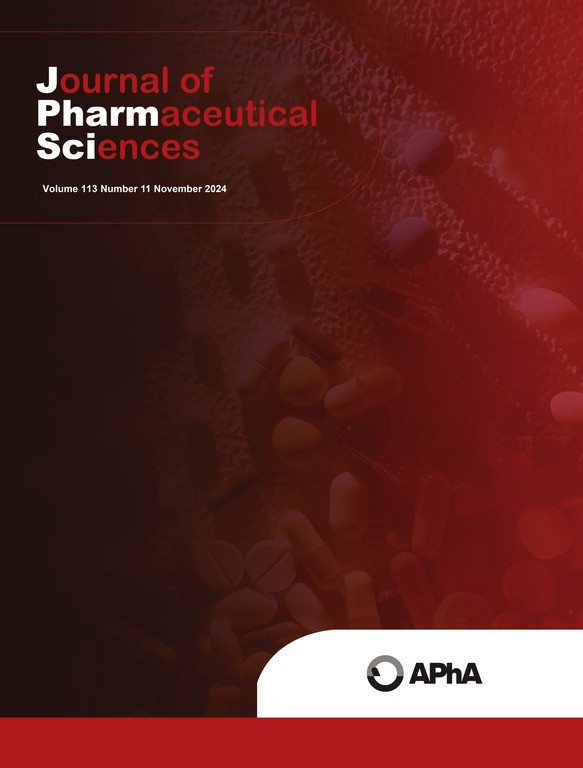原位形成溶剂诱导相转化(SIPI)植入物用于控制药物递送:亲水性聚合物的作用。
IF 3.7
3区 医学
Q2 CHEMISTRY, MEDICINAL
引用次数: 0
摘要
近年来,有大量的研究集中在原位形成的植入物作为一种局部药物输送的方法。尽管取得了一些进展,但SIPI植入物的主要挑战是显著的爆裂释放,通常发生在给药后24小时内。另一个值得注意的挑战是这些植入物的实时表征,这对于了解它们的原位形成和降解机制至关重要。本研究探讨了各种亲水性聚合物——羟丙基甲基纤维素(HPMC)、羟丙基纤维素(HPC)、卡波波尔和羧甲基纤维素(CMC)对植入物形成和药物释放的影响。SIPI系统通常由聚乳酸-羟基乙酸(PLGA)和n -甲基吡咯烷酮(NMP)组成,可提供局部可控的药物释放,但在给药后24小时内出现初始爆裂。掺入亲水性聚合物的目的是调节这种释放并改善植入物的性能。首次,光学相干断层扫描(OCT)成像用于非侵入性评估原位相位反转率和由此产生的种植体形态,而扫描电子显微镜(SEM)和数字显微镜提供了对种植体内部结构的进一步了解。结果表明,聚合物(如HPMC和Carbopol)的加入有效地减少了爆裂释放,而聚合物(如HPC和CMC)的相转化速度更快,导致植入物形态更多孔,爆裂释放更大。此外,对配方的机械性能和粘接能力进行了测试,表明carpol增强植入物特别适合需要在粘膜部位长时间保留的应用。本研究为SIPI给药系统的设计和优化提供了重要的见解。本文章由计算机程序翻译,如有差异,请以英文原文为准。

In-situ forming solvent-induced phase inversion (SIPI) implants for controlled drug delivery: Role of hydrophilic polymers
In recent years, there has been a surge of research focused on in situ-forming implants as a method of localized drug delivery. Despite advancements, the predominant challenge in situ-forming solvent-induced phase inversion (SIPI) implants is significant burst release which typically occurs within the first 24 h post-administration. Another notable challenge is the real-time characterization of these implants, which is crucial for understanding their in situ formation and degradation mechanism. This study explores the impact of various hydrophilic polymers—hydroxypropyl methylcellulose (HPMC), hydroxypropyl cellulose (HPC), Carbopol, and carboxymethylcellulose (CMC) - on implant formation and drug release. SIPI systems, which are commonly composed of poly(lactic-co-glycolic acid) (PLGA) and N-methyl pyrrolidone (NMP), offer localized, controlled drug release but suffer from an initial burst within 24 h post-administration. The incorporation of hydrophilic polymers aims to modulate this release and improve implant properties. For first-time, optical coherence tomography (OCT) imaging was employed for non-invasive assessment of the rate of in situ phase inversion and the resulting implant morphology, whereas scanning electron microscopy (SEM) and digital microscopy provided further insights into the internal structure of the implants. The results demonstrated that the inclusion of polymers such as HPMC and Carbopol effectively reduced burst release, whereas polymers such as HPC and CMC exhibited faster phase inversion, resulting in a more porous implant morphology and greater burst release. Additionally, the mechanical properties and mucoadhesive capabilities of the formulations were tested, suggesting that Carbopol-enhanced implants are particularly suitable for applications requiring prolonged retention at mucosal sites. This investigation provides critical insights into the design and optimization of SIPI systems for drug delivery.
求助全文
通过发布文献求助,成功后即可免费获取论文全文。
去求助
来源期刊
CiteScore
7.30
自引率
13.20%
发文量
367
审稿时长
33 days
期刊介绍:
The Journal of Pharmaceutical Sciences will publish original research papers, original research notes, invited topical reviews (including Minireviews), and editorial commentary and news. The area of focus shall be concepts in basic pharmaceutical science and such topics as chemical processing of pharmaceuticals, including crystallization, lyophilization, chemical stability of drugs, pharmacokinetics, biopharmaceutics, pharmacodynamics, pro-drug developments, metabolic disposition of bioactive agents, dosage form design, protein-peptide chemistry and biotechnology specifically as these relate to pharmaceutical technology, and targeted drug delivery.

 求助内容:
求助内容: 应助结果提醒方式:
应助结果提醒方式:


